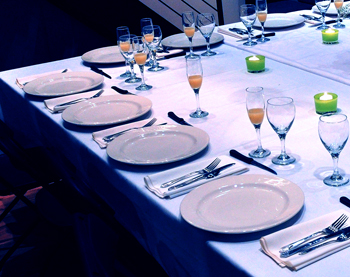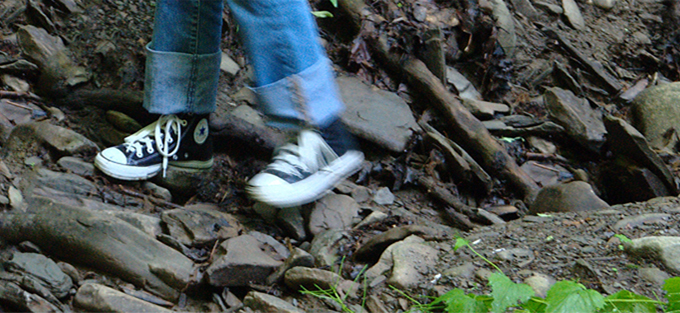by Samantha Nichols
This past summer, I accidentally climbed a mountain. I imagine that most people who climb mountains do so intentionally. I knew I was at a state park. I knew there was a mountain. I even knew I was on one of the summit trails. But I expected a trail that would move in a slightly upward direction. Instead, I began climbing a mountain, lifting myself from one steep rock to the next. I can’t help but think of this adventure as I consider my introduction to interfaith leadership.
I started an Interfaith group on my campus, by accident too.
I discovered the Interfaith Youth Core through a Google search one day, while looking for relevant job opportunities. Before I knew it, I was attending the 2013 Chicago Interfaith Leadership Institute (ILI). I expected to learn about different religions but what I discovered was an entire Interfaith movement. I was suddenly aware of the “Better Together” campaign and was inspired to become an interfaith leader myself.
Starting at the beginning
After attending the ILI, I started the frustrating process of creating an official student organization. I cleared the necessary administrative hurdles and was excited to say that Missouri State had a brand new interfaith dialogue and service club: Linked. Linked had the official paperwork, mission and enthusiasm. Unfortunately, it also only had one member. Eventually, people started coming to meetings and a small but passionate group formed the club’s core membership base.
In April of 2014, three people were shot and killed in my hometown. The tragedy would quickly be labeled a hate crime against the Jewish community. Linked organized an interfaith vigil to remember the three people who had lost their lives, rally around our Jewish community and offer a space for healing and compassion. It was a powerful night, one that I will never forget. The daughter of one of the victims read scripture from her parents’ wedding and shared her younger cousin’s view of the tragedy: the shooter wasn’t full of hate; he had simply forgotten how to love.
This powerful experience energized our small group and so we immediately got to work. We focused on engagement over mere coexistence and sought to remind one another how to love. We met weekly to plan events and engage in conversations ranging from suffering to protecting the environment to poverty. On one occasion, we expanded this weekly meeting style for a more public event, “Talk Better Together.” We organized service projects. We regularly served dinner at and collected items for a local homeless shelter. We also volunteered at a shelter for domestic violence survivors. These service events were important opportunities for us to move from dialogue to action and exemplify how we can indeed work together. All of these events pushed us to explore not only our similarities, but also our differences.
All are welcome
 I grew up in the ELCA hearing over and over that God is love. Sunday school lessons reminded me to value hospitality. Also the sacrament of Communion is a time to connect to God and is a model of hospitality. My pastor would always say, “This is the Lord’s table. All are welcome.”
I grew up in the ELCA hearing over and over that God is love. Sunday school lessons reminded me to value hospitality. Also the sacrament of Communion is a time to connect to God and is a model of hospitality. My pastor would always say, “This is the Lord’s table. All are welcome.”
What a beautiful image! I see a table, prepared for everyone, where stories and laughter are to be shared. I see a natural connection between these beliefs and interfaith dialogue.
Jesus commands us to love our neighbors. His parable of the Good Samaritan reminds us that our neighbors may believe differently than we do, but they deserve our love and care all the same. We must not overlook his openness to change, to being more inclusive and hospitable.
Interfaith dialogue is only possible when we are welcoming. In response to the question, “Why Lutheran?” our former Presiding Bishop Mark Hanson, noted that the Lutheran tradition emphasizes our relationships with others, not what sets us apart.
Interfaith dialogue is at its best when differences are explored and not simply pushed aside, but the exploration and discussion takes place in community. In addition to understanding what makes us different, we can find and celebrate the values we have in common. We can do good work in the world for different reasons, but still do that good work together.
As Christians, I believe we are called to not only live in community, but to build and strengthen communities. Interfaith dialogue is a crucial part of that because God has blessed our communities with diverse peoples and perspectives.
I accidentally discovered interfaith leadership just like I accidentally climbed a mountain. Both experiences pose their challenges, but both offer abundant rewards. The view from Pinnacle Mountain was beautiful, but the vision I have for the ELCA, the global body of Christ, and all of God’s people is even more beautiful. It’s a vision of love, justice and compassion and it becomes a reality through building relationships, strengthening communities and engaging in interfaith dialogue and service.
Discussion questions:
1. Why is interfaith dialogue important?
2. What are some challenges we might face as we seek to engage in interfaith dialogue and service?
3. What about the Christian faith, and particularly the Lutheran tradition, might compel us to be interfaith leaders?
Closing prayer:
Loving God, you call us to live in, organize, and serve communities. You have blessed us with diverse perspectives which make our communities more vibrant. Please guide us to better understand these different beliefs so that we may live in harmony rather than conflict, seek justice together rather than alone, and offer to others the radical hospitality that you have offered to us. Amen.
Samantha Nichols is her first year of seminary at the Lutheran School of Theology at Chicago. She is seeking a Master of Divinity with hopes of becoming a pastor for the ELCA. A graduate of Missouri State University, Samantha majored in Religious Studies and minored in Ozarks Studies. She received the Mike Hammer Interfaith Leadership Award from Interfaith Youth Core in 2015.
Photo of hiking by Carol Mueller. Used with permission. Photo by Brando Bean. Used with permission.


As a life-long Lutheran, I felt called to begin a women’s interfaith discussion group five years ago at my suburban Houston Lutheran congregation. Part of this was a result of my job as a public librarian where I dealt daily with a diverse population. The other part was a desire to follow Jesus’ model and help move my congregation beyond its walls out into that diversity. We needed to begin by knowing our neighbors.
Over the years we have centered our discussions around books (notably “The Faith Club” and “Faithfully Feminist”), around general topics (marriage, raising children, sacred books, prayer, etc.), and around an online dialogue guide (“Interfaith Dialogue Guide for Everyday Leaders”). I am interested in any resources your group used to structure your discussions, and the format you used for your “Talk Better Together” public event.